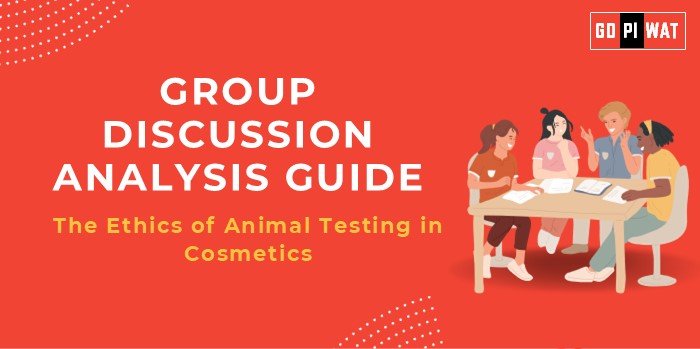📋 GROUP DISCUSSION (GD) ANALYSIS GUIDE: Animal Testing in the Cosmetic Industry
🌐 Introduction to the Topic
Opening Context:
“The use of animals for testing cosmetic products remains a contentious ethical issue, balancing human safety needs against animal welfare. Globally, countries and companies are reevaluating the practice amid growing consumer demand for cruelty-free products.”
Topic Background:
The practice of animal testing dates back to the early 20th century when it was essential to ensure human safety. However, advances in technology and rising ethical standards have prompted bans in over 40 countries, including the European Union, India, and Israel.
📊 Quick Facts and Key Statistics
- 🌍 Global Ban on Animal Testing: Over 40 countries have banned cosmetic animal testing, highlighting a global shift toward cruelty-free products.
- 💼 Cruelty-Free Products Market: Valued at $8 billion in 2023, expected to grow at a CAGR of 6.5% (2024-2028).
- 🤖 Technological Alternatives: In-vitro and AI-based testing methods have reduced dependency on animal models by 30% globally.
- 🛍️ Consumer Behavior: 73% of global consumers prefer cruelty-free brands (Nielsen Survey, 2023).
🧩 Stakeholders and Their Roles
- 🏛️ Governments: Enact and enforce bans on animal testing; promote alternative methods.
- 💼 Cosmetic Companies: Innovate testing methods to ensure safety without animal harm.
- 📢 NGOs and Advocacy Groups: Push for global adoption of cruelty-free practices.
- 🛍️ Consumers: Drive demand for ethical products through purchasing power.
- 🔬 Scientific Community: Develop and validate alternative testing models.
🏆 Achievements and Challenges
✨ Achievements:
- ✔️ Legislative Progress: India banned animal testing for cosmetics in 2014, showcasing ethical leadership.
- ✔️ Technological Innovation: Alternatives like organ-on-chip and 3D tissue models.
- ✔️ Industry Shift: Major brands such as L’Oréal and The Body Shop adopt cruelty-free policies.
⚠️ Challenges:
- ❌ Lack of Global Consensus: Countries like China require animal testing for imported products.
- ❌ Cost Barriers: Alternatives can be expensive to develop and implement.
- ❌ Effectiveness: Limited scope for alternatives in some toxicity tests.
🌎 Global Examples:
- 🇪🇺 EU and India: Lead with bans, setting global ethical benchmarks.
- 🇨🇳 China: Still mandates tests for imported goods, complicating global alignment.
💬 Structured Arguments for Discussion
- Supporting Stance: “Animal testing is unethical as viable alternatives exist. Countries like the EU demonstrate that safety and ethics can coexist.”
- Opposing Stance: “Safety must be prioritized, and in some cases, alternative methods are not yet robust enough to replace animal testing entirely.”
- Balanced Perspective: “While alternatives are the future, a phased approach balancing safety, cost, and ethics is necessary.”
📚 Effective Discussion Approaches
Opening Approaches:
- 💭 Ethical Perspective: “Is it justifiable to harm animals for vanity, especially when alternatives exist?”
- 💡 Technological Angle: “With innovations like AI-based testing, animal testing is becoming obsolete.”
Counter-Argument Handling:
- ✔️ Highlight flaws in alternatives, e.g., cost or reliability.
- ✔️ Emphasize shared ethical and practical middle grounds.
📈 Strategic Analysis of Strengths and Weaknesses
- ✔️ Strengths: Rising consumer demand for cruelty-free products; legislative support.
- ❌ Weaknesses: Lack of universal adoption; cost and accessibility of alternatives.
- 💡 Opportunities: Global collaborations for innovation; expanding cruelty-free markets.
- ⚠️ Threats: Resistance from countries with mandatory testing laws; limited awareness.
🏫 Connecting with B-School Applications
Real-World Applications:
- 🌟 CSR strategies focusing on ethical practices.
- 📊 Consumer behavior analysis and market trends.
- 📚 Ethical decision-making models for leadership.
Sample Interview Questions:
- ❓ “What are the implications of banning animal testing for cosmetic brands?”
- ❓ “How can companies balance ethics and profitability in this domain?”
Insights for Students:
- 💼 Understanding consumer ethics and evolving preferences.
- 🤖 Leveraging technology for sustainable practices in business.


